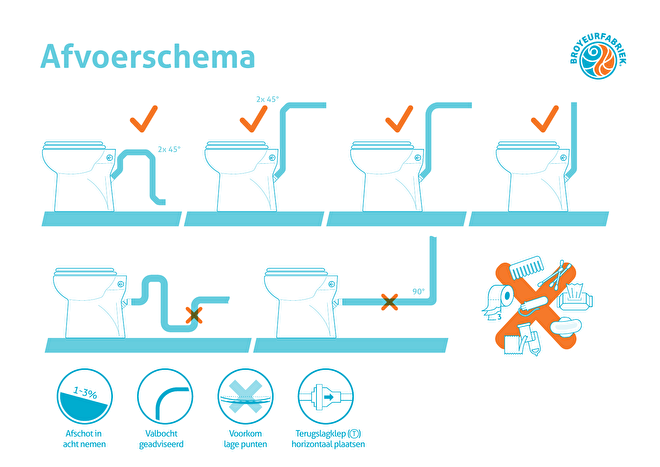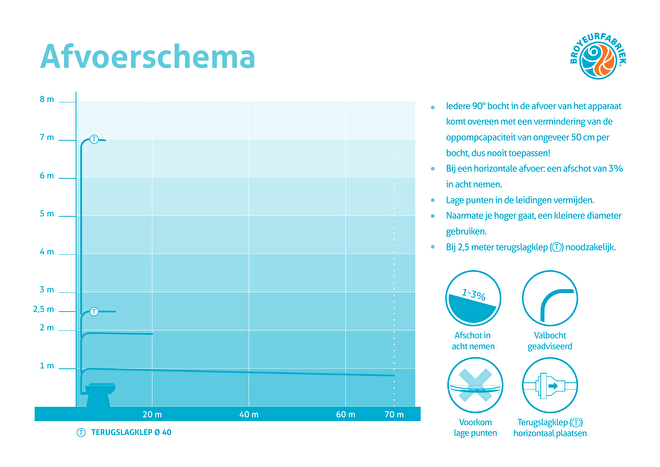Frequently asked questions
(1) What is a macerator? And also: What does the word broyeur mean exactly?
The word Broyeur is a French word, that in this context means "macerator" or "grinder". The very first toilet macerators originally came from France. The standard diameter of the sewer connection in France is only 100 mm versus the de-facto standard of 110 mm in the Netherlands for example. This made it generally necessary to install a fecal macerator behind the toilet in order to prevent clogging. Once macerated, the wastewater can of course be pumped away via piping with a smaller diameter, such as 40 mm or 32 mm. Just to be precise: the term "macerating WC" can also refer to a toilet which has the macerator fully integrated in the ceramics (as is the case with the majority of our models).
(2) Is there a simple installation schematic which I can use when installing?
Naturally. We have prepared the below graphical representation for you.
It is however advisable to review the other paragraphs on this page, especially if you have questions pertaining to your specific situation.


(3) I wish to pump upwards using a macerator. Which is the preferred diameter PVC pipe to use?
If, for example, you wish to pump to a higher floor because you do not have a drain on the floor where you wish to install the macerator, it is best to use a pipe with a diameter of 32 mm. This will increase the pressure considerably compared to a 40 mm. drainpipe.
After pumping up, the horizontal section should be carried out in 40 mm. and should preferably be laid on a slope (between 1 cm and 3 cm per horizontal metre) towards the sewer.
(4) If I wish to pump upwards, should I always install a non-return valve?
Not always.
In the case where you connect the drain of your macerator on a higher floor to an existing drain, for example by using a T-piece, it is possible that the waste water of the items that were connected to this existing drain (such as a kitchen, shower, washing machine, etc.) will reach the lowest point of your broyeur. A non-return valve does help to stop this waste water from the appliances on that floor so that it does not run into your macerator. Keep in mind, however, that depending on the height at which you install the non-return valve, your pipe may remain filled with waste water from the upper floor.
(5) I want to pump upwards, but horizontally for the first couple of meters and then up after that, is that possible?
No (In fact, you should avoid this scenario in order to prevent problems).
In principle, you should always first pump upwards through a 32 mm. tube and then horizontally through a 40 mm tube. Theze diameters should not be applied in reverse order since this will introduce a 'bottleneck' effect. Install the horizontal (40 mm) tube preferably on a slope and ensure a height-difference between 1 cm and 3 cm per horizontal metre.
(6) I wish to divert the waste water from a macerator in our garden house to our house. The distance to the house is 25 meter and the height difference of the drain is approximately 40 cm. Can I dig in the PVC tube and connect it at a slightly upward slope / elevated?
No. This is simply impossible and would cause problems.
It is always best to pump up first and only then horizontally (and preferably on a slope: between 1 cm and 3 cm slope per horizontal metre).
(7) I have to have my shower drained to a higher floor by a macerator. The floor of my basement is uneven so that the broyeur is higher than my shower cabin. Will the macerator also suck the water from my shower tray?
No. Macerator pumps do not actually suck wastewater at all.
A macerator can best be seen as a drain, so the waste water should run to it on a sufficient slope. There are of course pumps that do suck: for more information about such (dirty water) pumps, we would like to refer you to our product range.
(8) I connected the condensation water from my Central Heating to a macerator. The macerator is full of water after a week, runs over and doesn't pump anything away!
In most macerator systems, a float switch is used to detect the water level inside the macerator unit. When a certain water level is reached, the float activates the pump, triggering it to start grinding and pumping the waste. The float is essential for the proper operation of the pump, ensuring that the system only runs when there is sufficient water to trigger it.
However, in certain situations, such as when condensation water from a boiler drips into the macerator’s sump or tray, the amount of water entering the system may be too small to displace enough air to activate the float. In this case, the water may not raise the float enough to trigger the pump, causing the macerator to fail to start.
(9) My separate macerator, located behind the toilet, regularly fills up with water without me even using the toilet. Is it broken?
Luckily there's nothing wrong with the macerator. There may be several causes:
1. Your cistern allows some water through, this is very little and sometimes not visible to the naked eye but it is sufficient to even let the macerator run over after a certain period of time, or to let it switch on out of nowhere. Cleaning and removing limescale from the sealing rubber at the bottom of the cistern will usually solve this problem quickly.
2. If you pump upwards, it is possible that liquid will drip into your macerator. See also question 4 on this page.
(10) My separate macerator will sometimes spontaneously switch on without me using the toilet?
See also question 9 above, with the difference that sometimes a little more fluid enters the macerator at once, which can cause an air displacement that in turn causes the macerator to switch on.
(11) Can I use those kinds of wet-wipes and wet toilet paper in my macerator?
No.
A macerator will get clogged from these and this kind of waste can even cause irreparable damage to the motor in the long run. Such damage is therefore not covered by the warranty.
These toilet towels contain textile fibers that cannot be ground by the macerator. A macerator doesn't have problems with toilet paper, but does have problems with such fibre-wipes (even with only one such wipe).
(12) When using my macerator, water comes up in my washbin and shower.
If one simply places a T-piece between, for example, a drain of the washbasin, problems can result.
A Y-piece is always better because it forces the liquid in the right direction. If you want to reduce the pressure to be discharged because you want to put as little strain as possible on the siphon of the wash basin, etc., then use the SANIREDUCER. Applying the SANIREDUCER works effectively if the existing drainage system to which you want to connect the broyeur consists of a 40 mm. drainage pipe. A thicker pipe is also allowed. Of course, the installation of a thin bypass from the toilet to beyond all obstacles would be best. In that case, you do not have to lay a thick sewer pipe through your home.
(13) I am going to install a bathroom with macerator toilet, sink, shower and washing machine, in the corner is a 40 mm drain pipe which runs down. How should I run the drainpipes?
If everything still has to be laid, it's actually quite simple. The drains of the washbasin, shower and washing machine can be looped through to the corner of the room if desired. You should install the drain of the macerator toilet separately all the way to that corner and you can connect it with a 45 degree Y-piece to the drain. You can even have the drain of the toilet run over the wall if you still need to carpenter the wall.
Always use wide bends. So no short, but long corners. Of course we have the right type in our assortment.
(14) Do I have to decalcify my macerator internally?
It is best to clean the toilet bowl a number of times a year with decalcifying agents especially suited to macerator, that do not affect the gaskets and seals of the engine. Normal detergents can cause damage to macerator toilets. Macerator cleaning agent is something that we of course have in stock.
(15) When pressing the flush button on my macerator toilet, it doe s take water and I can hear the grinder, but barely anything gets pumped away. When pressing again things usually work better. What can this be?
As long as you can hear the engine, there's probably not much going of a problem. This can have several causes.
1. The connection socket of the toilet to which you have connected your drain is slightly kinked, it should be in the position indicated by the manufacturer.
2. There may be a foreign object lodged in the grinder and thus can not pass through. Look in the hose connected to the grinder and remove the object. If it is stuck, unscrew the self-tapping caps from the grinder and clean these.
3. You have a blockage in the drainage system to which the toilet is connected. It is also possible that your drainage system is not sufficiently aerated and is therefore not designed for 1 Bar of pressure that is applied to it. A cheap aerator is usually the solution in such a case.
Always first check whether the problem lies in the connections / the situation on location: this way you avoid unnecessarily exchanging a product under warranty and then unfortunately having to conclude that the problem did not lie with the purchased product.
The best test: disconnect the drain from the connection socket and make a loose connection to a bucket or other temporary collection/drainage for the rinsing water and press the rinsing button. If the toilet flushes, point 3 is already excluded and points 1 and 2 remain.
(16) When tilting the toilet during installation, I can hear a small object that seems difficult to locate apparently moving inside the porcelain.
Fortunately there's nothing wrong with your toilet. It happens regularly that during the baking process a pimple of porcelain comes loose in one of the cavities. This can never be prevented and fortunately is always invisible. It can only be heard when the toilet is tilted. Furthermore, this does not affect the operation of your toilet in any way. You can assemble the toilet without any problems and you will not be bothered by it.
(17) We do not use our macerator during winter: it is located in our summer house. What should we do to prevent freezing?
Use plenty of antifreeze and flush. While flushing, pull out the plug so that a lot of antifreeze remains in the crusher compartment. It is best to disconnect the toilet bowl and place it in the warm attic of your house during the winter.
(18) Our sewer pipes have subsided to the point that our regular toilet can barely function properly any longer. Can we connect a macerator toilet directly to the 110 mm sewer pipe?
Yes. This is basically possible.
In order for it to function optimally, it is best to use a flexible ribbed pipe of 40 mm. and run it into the sewer pipe as far as possible, preferably just over the subsidence. After that, you can simply use the macerator toilet unhindered just like you would use any other toilet.
(19) Someone told me that you require a special type of toilet paper for a macerator and you can only do 'number one' on such toilets. Is that correct?
No.
The toilets and also the separate macerator which we supply are suitable for normal toilet paper and for all types of human waste. However, avoid soft toilet paper because it usually contains textile: see also question 11 above.
(20) In the DIY store we bought a hanging toilet with frame in which we would like to install a separate broyeur. Are there any standard fitting dimensions for this?
There are no guidelines for putting a separate macerator in a frame of a hanging toilet. This depends on the creativity of the person installing it.
Preferably there should be a possibility to remove the macerator in case of calamities which can become problematic if the wall in front of/around the frame is neatly tiled. The macerator is after all an electrical device which could in theory fail for some reason.
This is the reason why there are hanging toilets with a macerator built directly into the ceramics, which can easily be reached if necessary. We also have such models in our product range.
(21) I feel as though a lot of water remains in my macerator toilet bowl after flushing. Is water supposed to remain inside my toilet bowl?
A lot of water must remain in the toilet after flushing so that stools cannot attach themselves to the ceramics. A macerator toilet slowly fills up with water during flushing and then pumps it away. A regular toilet, on the other hand, discharges 7 to 10 liters of water at a high speed through the toilet bowl so that the stool is flushed away with it.
In addition, the water also serves as an odour trap to stop unpleasant odours from the sewer.
A macerator toilet is connected to a water connection which is usually between 1 and 1.5 Bar. There are exceptions that in some cases the hydrophore of the utility company is set higher.
There is a case known from Zwolle where 3.5 Bar pipe pressure was applied to the water supply network, causing the toilet to fill up almost to the edge during the time the water timer runs off the toilet.
In such a situation it is advisable to close the water supply tap and then carefully adjust it so that the toilet fills up to an acceptable level during the time the toilet's water timer runs.
(22) When inspecting the back of my macerator toilet, I notice a small hose or tube with a black cap on it pointing upwards. What is this and should this be attached to something?
No.
This is the aerator / vent of the toilet. This tube should not be touched.
(23) I wanted to purchase a pump to remove dirty water from my washing machine or dishwasher, but I was advised to get a macerator pump. Is that correct?
Yes and no.
For a washing machine or dishwasher, you normally only need a dirty water pump if you need to move wastewater from the washing machine.
What determines whether to go for advice on a regular dirty water pump or a macerator is the number of installations that will be connected.
Firstly, many manufacturers recommend that either upon initial use or at intervals of one or more months, you occasionally run the washing machine on a special program that washes at 90 degrees Celsius. Additionally, for hygienic reasons, you may choose to wash laundry at high temperatures, which can be the case in hospitals or medical facilities.
However, many dirty water pumps and grinders are not designed to handle water temperatures of 90 degrees Celsius or higher. These typically have a maximum temperature of 45 degrees Celsius as prescribed by the manufacturer.









